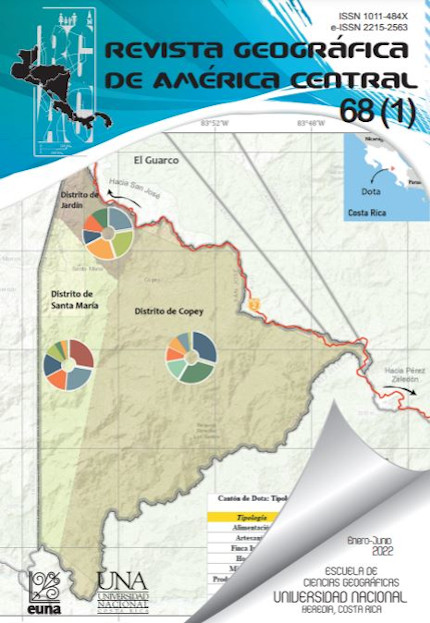Management of stormwater runoff from the perspective of ecosystem services. Analysis of its implementation in the main cities of Argentina
DOI:
https://doi.org/10.15359/rgac.68-1.11Keywords:
Urban planning, Water resource regulation, Stormwater management, Ecosystem services, ArgentinaAbstract
The inclusion of ecosystem services in the planning of urban spaces contributes to mitigating the hydrological impact of urbanization. Under this premise, the objective of the present work was to analyze the regulations associated with the management of stormwater in the capital and provincial capital cities of Argentina, and thus recognize background information regarding the implementation of policies that favor the provision of ecosystem services relevant to the regulation of water resources. Accordingly, zoning ordinances and codes were reviewed. The results obtained were grouped into: urban indicators, zones and green infrastructure measures. Although 87.5% of the considered cities exhibit some type of rule related to ecosystem services pertaining to the regulation of water resources, there is no explicit mention. The above situation makes it difficult to quantify the level of provision of ecosystem services and, therefore, hampers its effective inclusion in urban planning instruments.
References
Ahern, J., Cilliers, S., & Niemelä, J. (2014). The concept of ecosystem services in adaptive urban planning and design: A framework for supporting innovation. Landscape and Urban Planning, 125, 254-259.
Alcalá, L. I. (agosto, 2012). Avatares de la manzana. Entre la dispersión y la densificación. En: IX Bienal del Coloquio de Transformaciones Territoriales. Universidad Nacional de Tucumán, Argentina.
Altesor, A., Barral, M. P., Booman, G., Carreño, L., Cristeche, E., Isacch, J. P., Maceira, N., & Pérez, N. (2011). Servicios ecosistémicos: un marco conceptual en construcción. Aspectos conceptuales y operativos. En P. Laterra, E. Jobbágy & J. Paruelo, (Eds.). Valoración de Servicios Ecosistémicos: conceptos, herramientas y aplicaciones para el ordenamiento territorial (pp. 645-657). Buenos Aires: Ediciones INTA.
Argañaraz, J. P., & Lorenz, G. (2010). Contribución de las áreas verdes urbanas a la regulación del balance de agua en Santiago del Estero, Argentina. Bosque (Valdivia), 31(3), 231-242.
Avendaño-Leadem, D., Cedeño-Montoya, B., & Arroyo-Zeledón, M. S. (2020). Integrando el concepto de servicios ecosistémicos en el ordenamiento territorial. Revista Geográfica de América Central. 2 (65), 63-90.
Balvanera, P., Uriarte, M., Almeida-Leñero, L., Altesor, A., DeClerck, F., Gardner, T., … & Vallejos, M. (2012). Ecosystem services research in Latin America: The state of the art. Ecosystem Services, 2, 56-70.
Barros, V. R., Boninsegna, J. A., Camilloni, I. A., Chidiak, M., Magrín, G. O., & Rusticucci, M. (2015). Climate change in Argentina: trends, projections, impacts and adaptation. Wiley Interdisciplinary Reviews: Climate Change, 6(2), 151-169.
Bolund, P., & Hunhammar, S. (1999). Ecosystem services in urban areas. Ecological economics. 29(2), 293-301.
Laterra, P., Castellarini, F., & Orúe, M. E. (2011). ECOSER: Un protocolo para la evaluación biofísica de servicios ecosistémicos y la integración con su valor social. En P. Laterra, E. Jobbágy, & J. Paruelo, (Eds.). Valoración de Servicios ecosistémicos: Conceptos, herramientas y aplicaciones para el Ordenamiento Territorial (pp. 359-89). Buenos Aires: Ediciones INTA.
Chen, D., Li, J., Yang, X., Zhou, Z., Pan, Y., & Li, M. (2020). Quantifying water provision service supply, demand and spatial flow for land use optimization: A case study in the YanHe watershed. Ecosystem Services, 43, 101-117.
Daily, G. (1997). Nature’s services: societal dependence of ecosystems. Washington, D. C.: Island Press.
Ferro, M., & Minaverry, C. M. (2019). Aportes normativos, institucionales y sociales a la gestión del agua y el enfoque ecosistémico en la Cuenca del Río Luján, Argentina. Revista de Derecho (20), 25-55. Recuperado de: http://www.scielo.edu.uy/scielo.php?pid=S2393-61932019000200025&script=sci_arttext
Frantzeskaki, N. (2019). Seven lessons for planning nature-based solutions in cities. Environmental science & Policy, 93, 101-111.
Giaimo, C., Regis, D., & Salata, S. (2016). Ecosystem Services and Urban Planning. Tools, Methods and Experiences for an Integrated and sustainable territorial government. En Sustainable Buil Environment 2016 - "Towards post-carbon cities". Torino, Italia. Recuperado de: https://re.public.polimi.it/handle/11311/995171#.X20f4cJKjIU
Gómez-Baggethun, E., & Barton, D. N. (2013). Classifying and valuing ecosystem services for urban planning. Ecological Economics, 86, 235-245.
Gómez-Baggethun, E., Martín-López, B., Barton, D., Braat, L., Saarikoski, H., Kelemen, E., & Potschin, M. (2014). State of the art report on integrated valuation of ecosystem services. EU FP7 OpenNESS Project Deliverable, 4, 1-33.
González, S., Torchia, N., & Viand, J. (2015). Vulnerabilidad asociada a la ocupación de terrenos en áreas inundables. Cambio Climático e Inundaciones Urbanas Buenos Aires, Argentina: Secretaría de Ambiente y Desarrollo Sustentable de la Nación.
Grizzetti, B., Lanzanova, D., Liquete, C., Reynaud, A., & Cardoso, A. C. (2016). Assessing water ecosystem services for water resource management. Environmental Science & Policy, 61, 194-203.
Gittleman, M., Farmer, C. J., Kremer, P., & McPhearson, T. (2017). Estimating stormwater runoff for community gardens in New York City. Urban ecosystems, 20(1), 129-139.
Honorable Congreso de la Nación Argentina (26 de diciembre 2007). Ley 26331. Ley de Protección ambiental de los bosques nativos. Boletín Oficial N° 31310. República Argentina.
Honorable Congreso de la Nación Argentina (20 de noviembre 2019). Ley 27520. Ley de Presupuestos mínimos de adaptación y mitigación al cambio climático global. Boletín Oficial N° 99081. República Argentina.
Honorable Concejo Deliberante de Paraná (2018). Cuencas hidrográficas urbanas. Ordenanza 9668. Recuperado de http://190.183.231.163:4892/digesto/spip.php?article6679
Jansson, Å. (2013). Reaching for a sustainable, resilient urban future using the lens of ecosystem services. Ecological Economics, 86, 285-291.
Jullian, C., Nahuelhual, L., Mazzorana, B., & Aguayo, M. (2018). Evaluación del servicio ecosistémico de regulación hídrica ante escenarios de conservación de vegetación nativa y expansión de plantaciones forestales en el centro-sur de Chile. Bosque (Valdivia), 39(2), 277-289.
Kowalczyk, M., & Sudra, P. (2014). Ecosystem services in spatial planning. Europa XXI, 27, 5–18. doi: 10.7163/eu21.2014.27.1
Ley Provincial 11730. (2000). Bienes zonas inundables- Inundaciones. Boletín Oficial Santa Fe. República Argentina. Recuperado de https://www.santafe.gov.ar/index.php/web/content/download/128926/637160/file/Ley%20Provincial%2011730%20-%20Bienes%20zonas%20inundables.pdf
Maragno, D., Gaglio, M., Robbi, M., Appiotti, F., Fano, E. A. & Gissi, E. (2018). Fine-scale analysis of urban flooding reduction from green infrastructure: An ecosystem services approach for the management of water flows. Ecological Modelling, 386, 1-10.
Millennium Ecosystem Assessment. (2005). Ecosystems and Human Well-Being: A Framework for Assessment. Washington, DC: Island Press.
Minaverry, C. M. (2019). Enfoque ecosistémico, pago de servicios y análisis comparativo del marco legal para la protección de los bosques nativos en dos regiones forestales argentinas. En Ius et Praxis, 25(1), 441-480.
Organización de Naciones Unidas. (2015). Transformar nuestro mundo: la Agenda 2030 para el Desarrollo Sostenible. A/RES/70/1. Recuperado de: https://undocs.org/es/A/RES/70/1
Paruelo, J., Alcaraz-Segura, D. & Volante, J. N. (2011). El seguimiento del nivel de provisión de los servicios ecosistémicos. En P.Laterra, E. Jobbágy, & J. Paruelo, (Eds.). Valoración de Servicios ecosistémicos: Conceptos, herramientas y aplicaciones para el Ordenamiento Territorial (pp. 141-162). Buenos Aires: Ediciones INTA.
Pedersen, M. (2012). Ecosystem services analysis for the design of regenerative built environments. Building Research & Information, 40(1), 54-64.
Pickett, S. T., Cadenasso, M. L., Grove, J. M., Nilon, C. H., Pouyat, R. V., Zipperer, W. C. & Costanza, R. (2001). Urban ecological systems: linking terrestrial ecological, physical, and socioeconomic components of metropolitan areas. Annual review of ecology and systematics, 32(1), 127-157.
Rohrmann, H. y Schaller, O. (2016). Experiencias de 20 años en gestión de línea de ribera y zonificación de riesgo hídrico, Resistencia-Chaco. En Seminario Taller Línea de Ribera y Riesgo Hídrico. Facultad de Ingeniería y Ciencias Hídricas (FICH-UNLP). La Plata, Argentina.
Silvennoinen, S., Maija, T., Vesa Y., Harri K., Markku O. & Heikki, S. (2017). Monetary Value of Urban Green Space as an Ecosystem Service Provider: A Case Study of Urban Runoff Management in Finland.” Ecosystem Services, 28, 17–27. doi: 10.1016/j.ecoser.2017.09.013.
Secretaria de Ambiente y Desarrollo Sustentable. (2019). Protocolo: Ciudades Sustentables y Resilientes. Buenos Aires, Argentina.
Suárez, M., & Alba, D. (2017). Evaluación del impacto de las políticas del Ayuntamiento de Madrid en losservicios de los ecosistemas (2003-2015). CONAMA Local Valencia. Recuperado de : http://www.conama11.vsf.es/conama10/download/files/conamalocal2017/CT
Tan, P. Y., Zhang, J., Masoudi, M., Alemu, J. B., Edwards, P. J., Grêt-Regamey, A., Richards, D. R., Song, X. P. & Wong, L. W. (2020). A conceptual framework to untangle the concept of urban ecosystem services. Landscape and urban planning, 200, 103837.
Terraza, H., Rubio, D. & Vera, F. (2016). De ciudades emergentes a ciudades sostenibles. Santiago de Chile: Ed. ARQ.
Ullberg, S. (2013). Watermarks: urban flooding and memoryscape in Argentina. Tesis Doctoral. Universidad de Estocolmo. Recuperado de: http://www.diva-portal.org/smash/get/diva2:624415/FULLTEXT01.pdf
Viand, J. & González, S. (2012). Crear riesgo, ocultar riesgo: gestión de inundaciones y política urbana en dos ciudades argentinas. En Primer Encuentro de Investigadores en Formación de Recursos Hídricos. Buenos Aires, Instituto Nacional del Agua. Recuperado de:https://www.ina.gov.ar/pdf/ifrrhh/01_027_Viand.pdf
Villarreal, E. L. & Bengtsson, L. (2005). Response of a Sedum green-roof to individual rain events. Ecological Engineering, 25(1), 1-7.
Zhang, B., Xie, G.,Zhang, G., & Zhang, J. (2012). The Economic Benefits of Rainwater-Runoff Reduction by Urban Green Spaces: A Case Study in Beijing, China. Journal of Environmental Management, 100, 65–71. doi: 10.1016/j.jenvman.2012.01.015.
Zimmermann, E., Bracalenti, L., & Onocko, A. (2015). Infraestructura verde como alternativa sustentable para reducir el riesgo hídrico en áreas urbanizadas. Cuadernos del CURIHAM, (21), 55-69.
Published
How to Cite
Issue
Section
License
Proposed policy for journals offering Open Access
Authors publishing their works in the Journal acknowledge and agree to the following terms:
a) Authors retain the copyrights to their works and guarantee the Journal the right to be the first to publish their works, under the Creative Commons License Attribution-NonCommercial-ShareAlike 4.0 International, CC BY-NC-SA 4.0 International (https://creativecommons.org/licenses/by-nc-sa/4.0/deed.es), which allows others to share works upon complying with the acknowledgment of authorship and mention of the Journal as the original publisher of the work.
b) Authors are permitted to separately establish additional agreements for the non-exclusive distribution of the official edition of the work published in the Journal (for example, authors may desire to place the work in an institutional repository or incorporate it into a book that is to published elsewhere) so long they acknowledgment to recognize the Journal as the original publisher. The aforementioned additional agreements must respect the terms of the non-profit character and sharing philosophy of the original license (CC BY-NC-SA 4.0 International, https://creativecommons.org/licenses/by-nc-sa/4.0/deed.es).
c) Authors are encouraged to archive the post-print or editor/PDF version in Open Access repositories.







 REVGEO is licensed under https://creativecommons.org/licenses/by-nc-sa/4.0/deed.es
REVGEO is licensed under https://creativecommons.org/licenses/by-nc-sa/4.0/deed.es
.svg_4.png)

_(1).png)
_(1)_(1)_(1)_1.png)
(2)(1)(1)(1).png)
